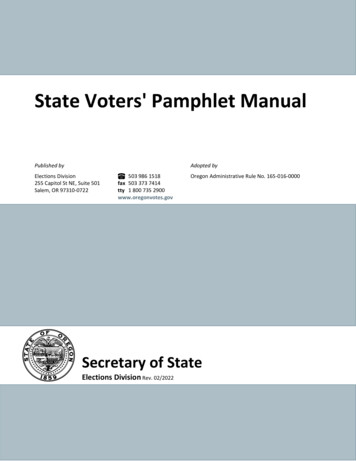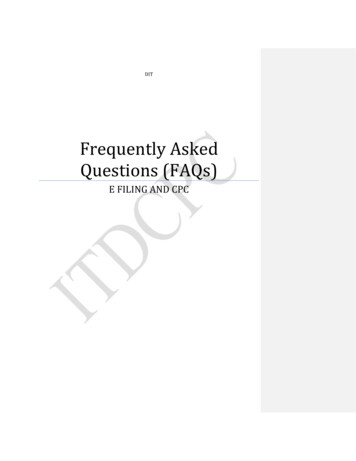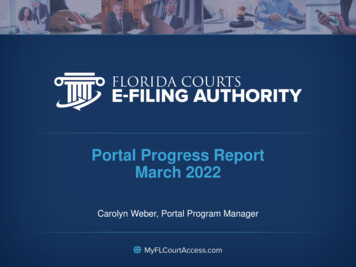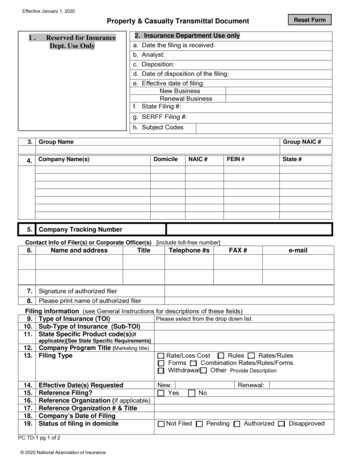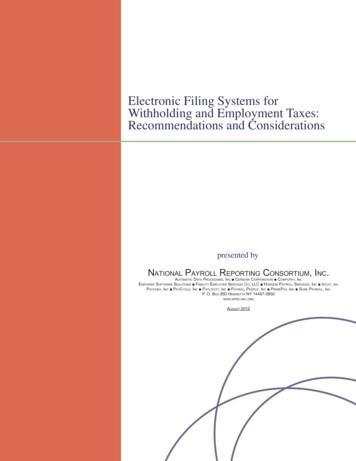
Transcription
Electronic Filing Systems forWithholding and Employment Taxes:Recommendations and Considerationspresented byNATIONAL PAYROLL REPORTING CONSORTIUM, INC.AUTOMATIC DATA PROCESSING, INC CERIDIAN CORPORATION COMPUPAY, INCEMPOWER SOFTWARE SOLUTIONS FIDELITY EMPLOYER SERVICES CO, LLC HORIZON PAYROLL SERVICES, INC INTUIT, INCPAYCHEX, INC PAYCYCLE, INC PAYLOCITY, INC PAYROLL PEOPLE, INC PRIMEPAY, INC SURE PAYROLL, INCP. O. BOX 850 HENRIETTA NY 14467-0850WWW.NPRC-INC.ORGAUGUST 2012
ExecutiveSummaryRevenue agencies typically have only one opportunity in a decade toupgrade the core systems that will drive and define agency workloadfor the next ten years. In today’s economic environment, no one canafford to waste resources unproduc vely. Given an opportunity, it ismore important than ever to carefully consider design alterna ves forelectronic filing systems for employment tax returns and employee/payee informa on returns such as Forms W-2 and 1099.At present, state tax authori es are in a period of sweeping changein electronic filing systems. These next genera on filing systemsraise opportuni es to increase e-filing and improve opera ng andadministra ve efficiencies for state agencies, employers, serviceproviders, and tax professionals.Payroll service companies have worked collabora vely with staterevenue agencies to improve electronic filing systems for many years.We have developed this document to provide background informa onand best prac ces for electronic filing systems. It contains consensusrecommenda ons for agency administrators, Informa on Technology (IT)administrators, and system integrators and developers that will: improve data quality;leverage the best in new technologies;increase administra ve efficiencies;reduce the burden to employers; andimprove employer customer sa sfac on.Deliberate considera on may make the difference between effec ve,efficient systems, and burdening agencies, employers and serviceproviders with substan al, permanent, and unproduc ve workload.Members of the NPRC look forward to working with each agency todevelop the most appropriate electronic filing systems for employmenttax repor ng.
table of contentsBackgroundPage 1Electronic Filing System Design ConsideraƟons & RecommendaƟonsPage 2RecommendaƟonsPage 3Appendix 1 - Format, Protocols, Gateway SpecificaƟons, TesƟngPage 10Appendix II - Social Security AdministraƟon EditsPage 16Appendix III - Amended ReturnsPage 17Appendix IV - Error CodesPage 18Contacts for AddiƟonal InformaƟonPage 22
BackgroundThe Na onal Payroll Repor ng Consor um (NPRC) is a non-profit tradeassocia on whose member organiza ons provide payroll, tax repor ng,tax payment, and related services to more than 1.4 million employersna onwide, covering more than one-third of the private sectorworkforce.The NPRC ac vely supports appropriate electronic filing and tax paymentprograms. In addi on to our long- me associa on and interac on withrevenue agencies, we have long worked with the IRS, SSA, and state UIagencies, as well as the following organiza ons to develop and improvestandards for electronic filing that make it easier for everyone to improveexis ng systems and develop new systems: Federa on of Tax Administrators (FTA)Na onal Associa on of State Workforce Agencies (NASWA)Associa on of Unemployment Tax Organiza ons (AUTO)IRS Electronic Tax Administra on Advisory Commi ee (ETAAC)IRS Advisory Commi ee (IRSAC)IRS Informa on Repor ng Program Advisory Commi ee (IRPAC)TIGERS group under ANSI ASC X12Many states have implemented, or are planning to implement newelectronic filing systems for employers and organiza ons that reporton behalf of employers. These next-genera on state electronic filingsystems have many features and func ons in common, which provideopportuni es to drama cally increase func onality and administra veefficiencies, increase electronic repor ng coverage, and improveemployer customer sa sfac on.For more than 30 years,NPRC members have supported taxadministration, wage reporting, taxpayments, and reporting systemsfor employers in every state in theUnited States.Our members, and the employerswe represent, share the goalof providing revenue and UIagencies with the most timely andaccurate wage and tax information.Our members understandagency data securityand integrity requirements,have demonstrated adherence tothese requirements, and, whennecessary, modified our ownmember systems as state agencyrequirements have evolved.NPRC recognizes that these systems must also provide for state-specificrepor ng requirements. However, in designing or modifying electronicfiling systems, the use of standards and common data formats makesit easier for so ware developers to implement them, while minimizingcostly post-implementa on maintenance. The following standards andbest prac ces will improve the systems, facilitate the developmentproject, and bring more employers into electronic filing.Our members have worked side-by-side with many state revenueagencies as they have migrated from paper-intensive tax/wagerepor ng systems, to magne c tape/cartridge repor ng systems, tomore sophis cated electronic filing systems. As states con nue toenhance electronic filing, our goal is to share the prac cal, “real-world”experience of state agencies, service providers, employers, and systemdevelopers to benefit other states as they develop new systems.1
ELECTRONIC FILING SYSTEM DESIGNCONSIDERATIONS & RECOMMENDATIONSOver one million small business employers and accountants usecommercial off-the-shelf and Web-based payroll tax so ware (e.g.,Quickbooks) to transmit their tax informa on and payments. Anaddi onal 1.4 million employers, who collec vely employ over one-thirdof the private sector work force, pay and file employment tax reports(including annual W-2s, quarterly and annual reconcilia ons, and newhire reports) to the IRS, SSA, state workforce and revenue agencies, andmunicipal tax authori es through an NPRC member company.Understandably, government IT Departments and Systems Developerso en concentrate on more-familiar stakeholders, who include individualtaxpayers, small businesses, bookkeepers, and accountants who typicallysubmit one return or payment at a me.However, Bureau of Labor Sta s cs (BLS) sta s cs show that althoughlarge employers represent less than 1/2 of one percent of employers,these large employers employ more than half of the U.S. workforce.Systems designed for individual submissions are not relevant for largeemployers and organiza ons that file in large volume (i.e., bulk or batchoriented filers). These organiza ons o en file thousands of returns toeach tax authority on any given day. Accommoda ng both individualand high-volume filers in system designs is necessary to enable broadelectronic filing par cipa on.The following pages describe design considera ons andrecommenda ons that can help with the development of electronic filingsystems that are usable by all stakeholders. Separate appendices arealso included to outline technical details, and suggested standards foremployment tax repor ng, including proposed error condi on handling.2
Recommendations1. Avoid Mandatory ‘Enrollment’for Electronic FilingAn enrollment program tells the tax authority howyou intend to file your return in advance of filinga return. This registra on is in addi on to theregistra on an employer must complete to establishtheir business with a tax authority. Generally, thesmall segment of tax authori es that have anenrollment component as part of their electronicfiling system do not accept electronically filedreturns for employers that did not “enroll” in theelectronic filing system. This should be recognized as adeparture from the paper (and even magne c media)world. When an employer registers, it is assumed thatthey will file required returns. It is not necessary totell the tax authority how they plan to file returns.Electronic filing programs in most states do nothave an enrollment component, as it can be a majorbarrier when a emp ng to expand electronic filingcapabili es. It creates an addi onal step in the filingprocess that did not exist with earlier filing modelsand can have the unintended consequence of slowingor even discouraging electronic tax administra on.In prac ce, e-file enrollment systems have becomean end to themselves, becoming in effect a pre-filingfiling involving detailed edi ng, acknowledgements,and so on. These systems require as muchdevelopment and ongoing maintenance by both thestate and the private sector as the actual electronicfiling system.Registra on may be necessary to enable an individualemployer to submit one-at-a- me transac ons via astate website. But with respect to reports submi edby transmi ers and bulk filers (who file on behalfof well over one-third of the private sector workforce), enrollment should not be a requirementprior to filing. Many clients begin using a payrollservice provider or decide to file electronically usingpurchased so ware on short no ce, some mes justbefore a return is due.Best Practices and StrategiesAlthough enrollment programs are not an essentialor a common component of most state electronicfiling systems, enrollment programs do exist in somestates. There are some best practices and strategies toconsider that help minimize the impact this additionalelectronic filing hurdle may present.Recommendations:1. Electronically filed returns that are both valid andforma ed correctly should be accepted and notrejected due to lack of enrollment.All clients of payroll service providers sign alimited power of a orney, usually based on theIRS Form 8655, Repor ng Agent Authoriza on.Form 8655 includes authorizing language relatedto state and local taxes, which expressly permitsthe service provider to deposit and file specifiedtaxes on clients’ behalf, and to receive otherwiseconfiden al informa on from the taxing authority.This authoriza on to receive informa on isintended to enable the payroll service providerto periodically verify relevant informa on of eachclient with the tax authority in order to improvethe accuracy of the data before filing a return.Most agencies, including the Social SecurityAdministra on (which processes employer W2 reports) have found it unnecessary to trackauthoriza ons between employers and payrollservice providers. The IRS tracks which employersare associated with which service providers, but3
only for the purpose of sending tax informa onto the service provider. Electronically filed returnsare accepted whether or not an authoriza on ison file.Similarly, State Workforce Agencies, (SWAs)are merely receiving required returns andpayments. Federal OMB Memorandum M-0404 (12/16/2003), E-Authen ca on Guidance forFederal Agencies, directs that authen ca onsystems should be risk-based, and provides thatsystems that only receive informa on are amongthe lowest risk ers. Virtually no tax authoritychecks each incoming payment to determine if theremi er is authorized to remit the tax in ques on.2. Adopt a Memorandum of Understanding (MOU)with high-volume e-filers to avoid the need totrack paper authoriza on forms.Payroll service providers have on file a copy ofeach authoriza on signed by clients. Many SWAsrely on a MOU to establish that the payroll serviceorganiza on has such forms on file for each clientand will provide a copy of any authoriza onon request. This approach saves the state fromthe considerable administra ve workloadinvolved in recording and storing copies of paperauthoriza on forms for each client.3. Automa cally enroll each taxpayer for electronicfiling, or otherwise prepare the electronic systemto accept returns without a separate “enrollment”transac on.If it is necessary to maintain an enrollmentfunc on, use exis ng mechanisms between thepayroll service providers or transmi ers and taxauthori es to populate the database. Trackingwhich provider is submi ng a return on behalfof a taxpayer can be easily accomplished throughthe use of the Taxpayer Informa on Valida onProgram. For details on this program, see TaxpayerInforma on Valida on Program Guide, at h p://www.nprc-inc.org/govcst.html.The ‘Request Type’ field in this program allowsthe provider to indicate to the tax authority thenature of the request. The provider has the abilityto denote which taxpayers are being added ordeleted for the tax period iden fied in the file.(See Appendix, Sec on 1, posi on 332, ‘RequestType’).4. Enrollment requirements that rely on theindividual taxpayer to take ac on before a serviceprovider can file o en causes confusion and delayfor all stakeholders involved in the filing process- - the taxpayer, the tax authority, and the serviceprovider.For instance, some enrollment programs requirethe individual taxpayer to assign administratorroles. Timing becomes cri cal and a myriad ofprocessing issues can result. If a taxpayer assignsan administrator role too early, this may block aprior service provider from filing the last wage/tax report. A taxpayer may inadvertently set upincorrect authoriza on levels, which can resultin misrouted and delayed correspondence whichmay include UI claim no ces. The inadvertenterror that is commonly seen is that an exis ngservice provider iden fica on code or new roleassignment could not be found by the taxpayer.In some cases, employers have created many new“Agents” on state systems when they were unableto find the exis ng record of their agent.5. Include the effec ve quarter date on theenrollment file to allow service providers toamend prior periods for former clientsIt is common when a client changes from oneservice provider to another for an overlap inservice to occur. A prior agent can be blockedfrom filing a last wage/tax report because a newservice provider has enrolled the client with thetax authority in prepara on for the upcomingquarter.Another scenario that some mes can occur is theprior agent inadvertently overwrites the currentenrollment authoriza on in order to be able tofile a necessary amendment. One way in whichthe payroll services industry differs from the taxprepara on industry is that only the organiza on4
that originally filed an employment tax return isable to automa cally analyze subsequent changesand prepare amended returns. Consequently,employers o en ask their prior (i.e., no longerauthorized) service provider to file amendedreturns, which requires extraordinary coordina onto re-establish the authoriza on of the priorservice provider, and then that of the currentservice provider once the amendment is filed.The current service provider believing they arealready successfully enrolled a empts to file atthe end of the quarter and realizes they mustcomplete the enrollment process again in a veryshort window of me. These addi onal stepsrepresent a new tax administra on burden butcan be properly managed through the use of theeffec ve dates in the enrollment file6. Authen cate the filing organiza on, and acceptall validly forma ed electronically filed returns.However, do not send informa on concerningemployer accounts un l an authoriza on is on file.2. Establish Appropriate EditsWhen designing next-genera on systems, there areopportuni es to improve the tax repor ng process byreevalua ng whether exis ng legacy error condi onsremain appropriate. And while it is temp ng toadd new edits when designing new electronic filingsystems, this can have the adverse effect of making itharder to file electronically than on paper.Employers are o en assessed significant penal esfor failing to pay workers on me. Furthermore, newcoordina on procedures between the SSA and theDepartment of Homeland Security o en result indelays in issuing new SSNs - even to workers whoare legally in the United States with a valid workauthoriza on. NPRC members and the employersthey represent follow SSA and IRS repor ng guidelinesand requirements. [See Appendix II for specificguidelines.] However, employers do employ and payworkers whose SSN and/or work authoriza on statusis pending, and when returns are due, their wagesmust be reported.Neither the SSA nor the IRS rejects employersubmissions due to errors in SSNs, name forma ng,or missing or incorrect addresses, etc. The federalagencies will generally only reject submissions whenthey are improperly forma ed (i.e. cannot be read).Recommendations:1. Adopt longstanding edits published by the SSA.Minimal ‘hard’ edits (i.e., resul ng in rejectedreturns) are most appropriate for UI wage andtax repor ng. The only edits that should beconsidered for such treatment are: State employer iden fica on numbers mustbe valid and ac ve. SSNs must be numeric. Required names cannot begin with a space(i.e., employee last name). Money amounts must be numeric and greaterthan zero.2. En re transmissions containing mul pleemployers should not be rejected for errors inone employer’s return. Correct data should beaccepted and posted. Only returns with errorsshould be rejected, or moved to a suspense filefor subsequent resolu on.3. If rejec on is necessary, the employer’s en rereturn should be rejected. State agencies shouldnot reject certain employee-level records whileaccep ng others within an employer’s return,wage report, or W-2 submission. Payroll repor ngsystems track employer- level submissions andare not designed to track, correct, and resubmitindividual employee records within an employer’sfiling. In addi on, if certain employee recordsare not accepted, the total of the suppor ngwage records or W-2 reports will no longer equalcompany-level totals reported on UI contribu onreturns or W-2/W-3 reconcilia on returns, andwill no longer match the payment amounts.4. Iden fy all error condi ons within rejected files. Afew states have rejected files when encounteringthe first few errors without reading the en re fileto iden fy all error condi ons. This has the effectof making the filing process itera ve, especiallyfor very large submi ers who must repeatedly5
resubmit en re files to iden fy all errors.(As each error is iden fied, it is resolved orremoved, and the en re file is resubmi ed toiden fy the next few errors, and so on.)5. Explicitly describe all edits within publishedspecifica ons. If new edits or changes to errorhandling are planned, state agencies shouldanalyze data previously reported by employersin exis ng electronic formats to determinethe impact of the proposed change. Plan toconduct significant educa onal efforts to adviseemployers of any changes to longstanding edits.states can increase accuracy and compliancewith new e-file systems if design specifica onsexplicitly describe all edits3. Integrate Pre-Filing TaxpayerInformation Validation with HighVolume Filers to Improve DataQualityDecades of experience with client taxpayers and taxauthori es have proven the necessity of verifyingclient en ty informa on prior to filing if at allpossible. Clients are o en not knowledgeableabout their status with the tax authori es andare occasionally unsure of their own employeriden fica on number (EIN), current tax rates orother requirements for filing and deposi ng payrolltaxes. They may provide cri cal informa on (e.g.,assigned tax rate) that is incorrect or outdated.If there have been en ty changes such as thepurchase of a business, merger, or change inpartners, outdated EINs or other informa on aresome mes provided.In terms of agency correspondence (e.g., balancedue no ces) related to tax returns filed, one largepayroll service provider found that agencies thatconduct rou ne taxpayer informa on valida onprograms eliminate over 97 percent of errors thatwould otherwise cause pos ng problems resul ngin a no ce. Said another way, tax authori es thatdo not take advantage of such programs generateas much as thirty mes the correspondence perreturn as agencies that do. Verifying such data on a prefiling basis is easily cost-jus fied in terms of improvingaccuracy and efficiencies for both the tax authority andthe submi er.Rou ne taxpayer informa on valida on typically takesthe form of electronic client lists that include every dataelement needed for the accurate processing of a taxreturn; usually state EINs, taxpayer name, assigned filingand deposit schedule, tax rates, and any other elementsthat vary by taxpayer and are needed for proper pos ng tothe tax account.The TIGERS organiza on is currently working within theFederal State Employment Tax (FSET) project to develop aformat for this data exchange, which would accommodateall service models. See www.statemef.com/fset.shtml fordetails (“Enrollment Data Exchange Schemas”). NPRC hasalso dra ed a Taxpayer Informa on Verifica on Programimplementa on guide, which explains the intended scopeand use of such programs, which can be found at h p://www.nprc-inc.org/govcst.html.Recommenda on: Integrate rou ne taxpayer informa onvalida on programs to iden fy error condi ons in advanceof filing due dates, so that any errors can be correctedbefore a return is filed.4. EarlyPhasesCollaborationinDesignInsufficient me allowed for systems changes is among theforemost problems faced by both industry and the states.One of the easiest ways to ensure broad acceptance anda smooth transi on is to involve industry partners early inthe development cycle. This communica on will help theindustry to implement modifica ons successfully by: improving understanding of the changes; allowing for orderly alloca on of resources; providing a communica on channel for concernsor implementa on challenges to the agency; and allowing for nego a on of prac calimplementa on issues, tes ng, and melines.By providing early warning and proposed specifica ons,state developers can also benefit from the experience6
Recommenda on: Offer electronic filing incen vesof interest to employers. For example, the IRS andsome states have made electronic services available toRecommenda on: Provide a minimum of six months electronic filers. These services benefit the state agenciesby enabling authorized self-service applica ons, whichlead me prior to the related tax period end datea er final specifica ons have been published (e.g., free up state personnel from handling rou ne requests viaphone or correspondence. These systems should include6/30 for the period ended 12/31, for wage reportsthe ability to view transac ons posted to client accounts,due 1/31).as authorized, and can also include electronic no ces,5. Consider Cost-Effectiveness of error handling, secure e-mail, and account resolu oncapabili es. New state systems should enable employersAutomationto view their account to verify that returns and paymentsare being credited to their account.Automa ng every element of UI tax repor ng isprobably not cost-effec ve for the state agency or7. Backup/Contingency Systemsemployers. For example, automa on of amendedreturns can be far more complex than automa onIt is important to consider backup and con ngency op onsof original returns, requiring separate analysisfor electronic filing when extraordinary circumstancesand programming to convert to electronic filing.result in an inability to mely file.Amended returns represent less than one percentof all UI tax filing volume, yet the size and scopeRecommenda on: State agencies should considerof the separate systems development requiredaccep ng data in the same format (e.g., FSET, EFW2) into support electronic filing of amended returnsa variety of media such as CDs. State agencies shouldmay exceed that of the core new system. To avoidalso consider offering an alternate transmission methodunnecessary development costs and maximizesuch as a backup secure FTP server or paper filings in theusage of exis ng systems, consider alterna veevent of some problem with the filing or transmissionapproaches for repor ng of correc ons such assystems. State system developers should considerusing exis ng filing formats and protocols forenabling authorized state personnel to accept and postcorrected submissions in replacement mode. [Seeelectronically filed returns received a er the deadlineAppendix III for specific guidelines.]as mely to accommodate temporary problems withthe electronic filing systems, and to suppress automatedRecommenda on: State agencies are encouragedto examine all aspects of new system development no ces.and automate only those func ons that are cost8. Offer ACH Credit and Debit foreffec ve for the agency and repor ng en es.of organiza ons that have implemented similarsystems in other states.Electronic Tax Payments6. E-ServicesState system developers must o en focus limitedresources on comple ng a task of limited scope,for example enabling electronic filing of certaintax returns. states may see greater system usage,administra ve efficiencies and cost savings byconsidering all interac ons and stakeholders.ACH Debit is appropriate for individual one-at-a- metransac ons and transmi ers that do not take possessionof employer funds. ACH Credit is a requirement andindustry standard for large payroll service providers, whichrou nely originate thousands or even tens of thousands oftax payments to each agency on any given day.Embedding ACH Debit instruc ons within electronicreturns is not appropriate for high volume submissions.7
Recommenda on: State agencies should consideraccep ng data in the same format (e.g., FSET,EFW2) in a variety of media such as CDs. Stateagencies should also consider offering an alternatetransmission method such as a backup secureFTP server or paper filings in the event of someproblem with the filing or transmission systems.State system developers should consider enablingauthorized state personnel to accept and postelectronically filed returns received a er thedeadline as mely to accommodate temporaryproblems with the electronic filing systems, and tosuppress automated no ces.8. Offer ACH Credit and Debit forElectronic Tax PaymentsACH Debit is appropriate for individual one-ata- me transac ons and transmi ers that do nottake possession of employer funds. ACH Creditis a requirement and industry standard for largepayroll service providers, which rou nely originatethousands or even tens of thousands of taxpayments to each agency on any given day.9. Use Established StandardsStandards facilitate programming for mul state so waredevelopers and service providers. Use of na onwidestandards, such as the FSET and other XML-basedsystems, and/or fixed file formats such as the SSA EFW2reduces programming changes and costs, and improvesadministra ve processes. Even when standards are used,detailed implementa on guides are necessary to specifysuch elements as:Transmission and security protocolsXML schemas and versions (if applicable)Forma ng preferencesLis ng of tax returns/return types supported (e.g.,amended returns, supplemental returns)Business rules and editsDetailed informa on about data elements (e.g., those thatare mandatory, op onal, condi onal, name tag protocol,minimum/maximum field length)Detailed informa on related to enrollment processes,rules, and editsEmbedding ACH Debit instruc ons within electronicreturns is not appropriate for high volumesubmissions. When there are file submission orprocessing problems and a file (or part of it) isrejected, it is not clear whether banking instruc onswere released and for which returns. This raisesthe risk that when corrected files are submi ed,duplicate bank transac ons will result. It is best tokeep tax payments and tax reports separate.Recommenda on: States are encouraged to offerboth debit alterna ves as well as ACH Credit. Statesshould strive to enable all tax payments and filingsto be made electronically. For emergencies, sameday delivery of payments, such as via wire transfer,should be accommodated.8
Technical Appendicespresented byNATIONAL PAYROLL REPORTING CONSORTIUM, INC.AUTOMATIC DATA PROCESSING, INC. CERIDIAN CORPORATION COMPUPAY, INC.EMPOWER SOFTWARE SOLUTIONS FIDELITY EMPLOYER SERVICES CO, LLC HORIZON PAYROLL SERVICES, INC INTUIT,INCPAYCHEX, INC PAYCYCLE, INC PAYLOCITY, INC PAYROLL PEOPLE, INC PRIMEPAY, INC SURE PAYROLL, INCP. O. BOX 850 HENRIETTA NY 14467-0850WWW.NPRC-INC.ORG9
Appendix I:Format, Protocols, Gateway Specificationand Testing RecommendationsFormatA separate considera on from the mechanics of how to send and receive electronic files (electronic filingprotocols) is the specifica on of the format of the electronic files. The file format specifies in detail what dataelements should be included, along with related requirements (such as whether a par cular data element isalways required; whether it must always be numeric, etc.), as well as placement and sequencing within the fileand/or data element or field tag details (if applicable).Recommendations: An electronic filing system can follow a number of established electronic file formats, such as theSocial Security Administra on’s EFW2 format (h p://www.ssa.gov/employer/08EFW2.pdf), Na onalAssocia on of State Workforce Agencies/Interstate Conference of Employment State Agencies(NASWA/ICESA) (h p://www.workforceatm.org/ar cles/template.cfm?results art filename uitable.htm), or Federal-State Employment Tax (FSET). (h p://www.statemef.com/fset.shtml)By using a format that already is in use by other federal and/or state agencies, states will benefit fromthe experience of others in development and tes ng. Addi onally, it is less expensive for privateindustry to support a format that is similar to those already in use, and states will find a broaderaudience that is prepared to electronically file using widely accepted standard formats.Providing a clear mapping from the data currently collected on paper forms to the electronic formatwill reduce interpreta on errors and ensure that intended results are achieved. Consistent standardsacross electronic filing, magne c media, and paper also facilitate faster development and moreaccurate quality control, increasing the volume of electronically filed returns.Alterna ve Format: The FSET standard was developed by the TIGERS organiza on, which is part o
The Na onal Payroll Repor ng Consor um (NPRC) is a non-profi t trade associa on whose member organiza ons provide payroll, tax repor ng, tax payment, and related services to more than 1.4 million employers na onwide, covering more than one-third of the private sector workforce.







